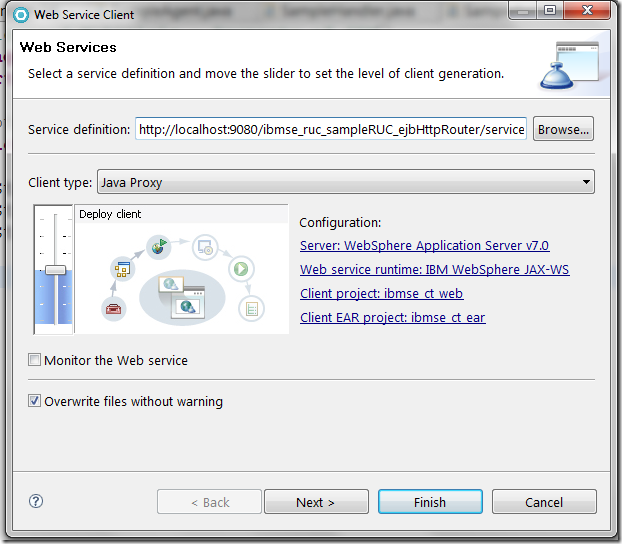一個RUC應用是運行在WSE Server上的,可以在WSE Console中維護。
RUC如何被使用?
RUC向外界暴露三種接口
1.MDB

2.WS


private SampleRemote_SEIProxy getSampleWS() { SampleRemote_SEIProxy rucWS = new SampleRemote_SEIProxy();
try { String endpoint = (new URL("http", RUC_SERVER_HOST, RUC_SERVER_PORT,
"/ibmse_ruc_sampleRUC_ejbHttpRouter/services/Sample"))
.toString();
rucWS.setEndpoint(endpoint);
} catch (MalformedURLException e) { e.printStackTrace();
}
return rucWS;
}
3.SLSB
private SampleRemote getSampleSLSB() throws NamingException { InitialContext ic = new InitialContext();
logText("Looking up ejb/ruc/Sample in InitialContext"); SampleRemote ruc = null;
Object stub = ic.lookup("ejb/ruc/Sample"); if (stub != null) { logText("Found non-null ejb/ruc/Sample in InitialContext"); ruc = (SampleRemote) PortableRemoteObject.narrow(stub,
SampleRemote.class);
} else
logText("Could not find ejb/ruc/Sample in InitialContext"); return ruc;
}
RUC如何使用其他的接口?
它也在使用其他的服務,服務分為兩種,一種是WSE內部的,例如DB。
另外一種是外部的,如ruc.maximo. 首先,內部的接口比較容易被使用,形成了SLSB,JMS,DB三種最容易的方式。使用外部的服務則麻煩一點,例如ITS或maximo,在Maximo中 ,它具備IFM可以讓其他系統的集成容易一些,通過IFM生成的WSDL,可以在WSE中使用。于是RTAL中,WSE和Maximo的集成是這樣的:WSE中使用一個RUC,RUC調用targetBackend,這個targentBackend就是一系列的WS類。RUC agent通過這個backend模塊,使自己在WSE的其他taskagent看起來就像是內部模塊一樣。
